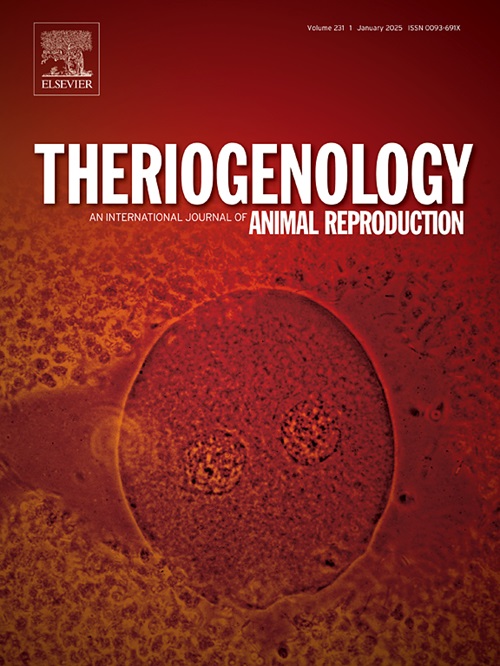Brain-derived neurotrophic factor (BDNF), an autocrine/paracrine regulator of basic ovarian functions and antagonist of kisspeptin
IF 2.4
2区 农林科学
Q3 REPRODUCTIVE BIOLOGY
引用次数: 0
Abstract
The aim of the present study was to examine whether brain-derived neurotrophic factor (BDNF) and BDNF-related molecules, such as the neuronal membrane glycoprotein M6a (GPM6A) and myocyte enhancer factor 2C (MEF2C), can be produced by ovarian cells and regulate ovarian cell functions as well as elucidate its functional interrelationships with the known regulator of ovarian cell functions kisspeptin (KP). For this purpose, we analyzed the expression of BDNF and GPM6A in rat ovaries and of BDNF, GPM6A and MEF2C in porcine ovarian granulosa cells; the influence of KP addition on the expression of BDNF, GPM6A and MEF2C; and the effects of BDNF, KP and the combination of BDNF + KP treatment on the proliferation, apoptosis and release of progesterone and estradiol by cultured porcine granulosa cells. The expression of BDNF, GPM6A and MEF2C was quantified by qPCR, and proliferation, apoptosis and hormone release were analyzed by BrdU incorporation, TUNEL and ELISA.
Our results demonstrate that both rat and porcine ovarian cells express BDNF and related molecules. Furthermore, the addition of BDNF stimulates the proliferation and release of progesterone and reduces the degree of apoptosis and estradiol output by porcine cells. KP has the opposite effect on these parameters. Furthermore, KP reduces the expression of BDNF and GPM6A but not MEF2C and suppresses the effects of BDNF on porcine granulosa cell apoptosis as well as progesterone and estradiol release. These observations are the first to demonstrate (1) the production of BDNF, GPM6A and MEF2C in the ovary, (2) the ability of BDNF to regulate ovarian cell proliferation, apoptosis and steroid hormone release by porcine ovarian cells, and (3) the antagonism between BDNF and KP production and their control of ovarian functions.
脑源性神经营养因子(BDNF),基本卵巢功能的自分泌/旁分泌调节剂和kisspeptin拮抗剂
本研究的目的是研究脑源性神经营养因子(BDNF)和BDNF相关分子,如神经膜糖蛋白M6a (GPM6A)和肌细胞增强因子2C (MEF2C)是否可以由卵巢细胞产生并调节卵巢细胞功能,并阐明其与已知卵巢细胞功能调节剂kisspeptin (KP)的功能相互关系。为此,我们分析了BDNF和GPM6A在大鼠卵巢中的表达,以及BDNF、GPM6A和MEF2C在猪卵巢颗粒细胞中的表达;KP添加对BDNF、GPM6A和MEF2C表达的影响;BDNF、KP及BDNF + KP联合处理对培养的猪颗粒细胞增殖、凋亡及孕酮和雌二醇释放的影响。qPCR检测BDNF、GPM6A和MEF2C的表达,BrdU结合、TUNEL和ELISA检测细胞增殖、凋亡和激素释放情况。结果表明,大鼠和猪卵巢细胞均表达BDNF及相关分子。此外,BDNF的加入刺激了猪细胞的增殖和黄体酮的释放,降低了细胞的凋亡程度和雌二醇的输出。KP对这些参数有相反的影响。此外,KP降低BDNF和GPM6A的表达,但不降低MEF2C的表达,并抑制BDNF对猪颗粒细胞凋亡以及孕酮和雌二醇释放的影响。这些观察结果首次证明了(1)卵巢中BDNF、GPM6A和MEF2C的产生,(2)BDNF调节卵巢细胞增殖、凋亡和类固醇激素释放的能力,以及(3)BDNF和KP的产生及其对卵巢功能的控制之间的拮抗作用。
本文章由计算机程序翻译,如有差异,请以英文原文为准。
求助全文
约1分钟内获得全文
求助全文
来源期刊

Theriogenology
农林科学-生殖生物学
CiteScore
5.50
自引率
14.30%
发文量
387
审稿时长
72 days
期刊介绍:
Theriogenology provides an international forum for researchers, clinicians, and industry professionals in animal reproductive biology. This acclaimed journal publishes articles on a wide range of topics in reproductive and developmental biology, of domestic mammal, avian, and aquatic species as well as wild species which are the object of veterinary care in research or conservation programs.
 求助内容:
求助内容: 应助结果提醒方式:
应助结果提醒方式:


